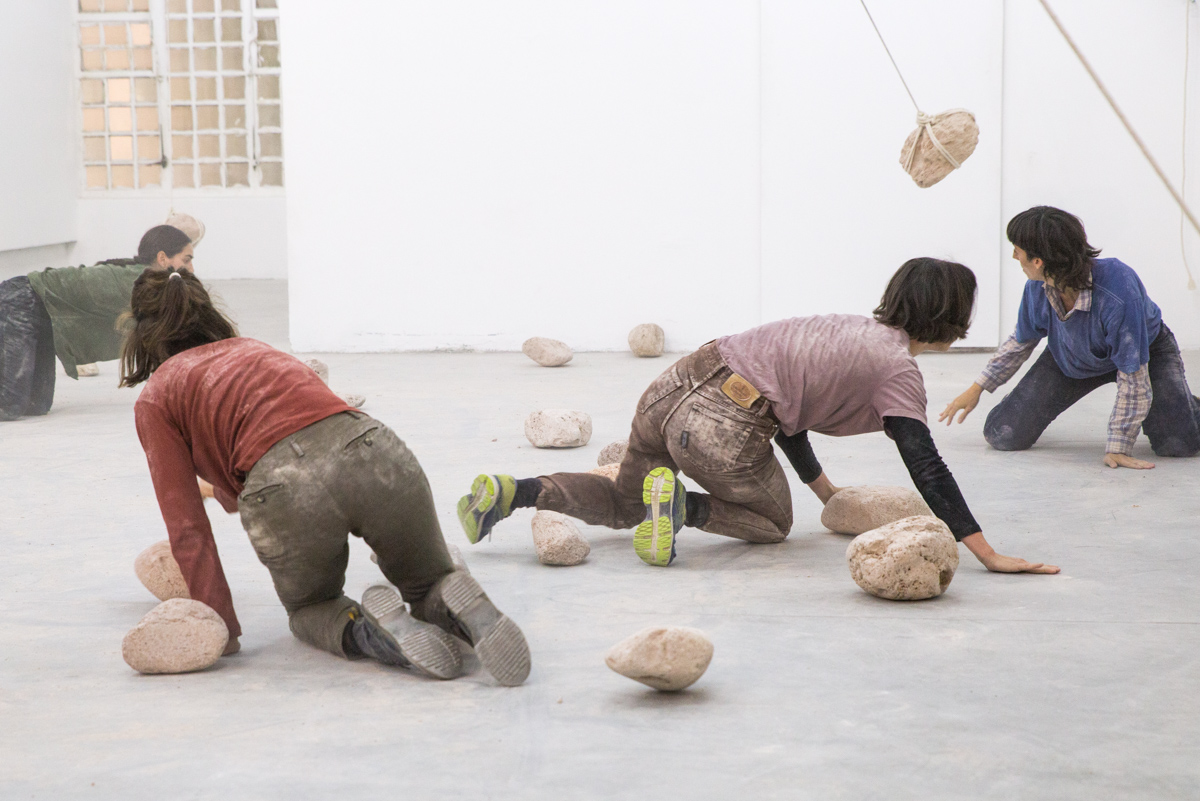Expanded Educational Praxis
04/17/2022
To think of ways of linking the fields of art and education is to imagine possible strategies for modifying the established reproductive mechanism, a difficult task when the owners of knowledge have the means to affirm relations of power/knowledge and the possibility of setting aesthetic and pedagogical agendas through publications, access to subsidies, the media, festivals, biennials and cultural institutions (…)
Art and Education: Problems Concerning its Connections
«The decolonial power of education and art allows to confront the hegemonic, cultural, and contemporary discourse of thought, constructed on the bases of capitalism, colonialism, and patriarchy, three concepts that overwhelm, liquidate, and make the other and the many forms of possible worlds invisible.»
Undoubtedly, there is a vast theoretical production and academic events regarding the field of the so-called 'Latin American Critical Pedagogies' aimed at training critical and reflective subjects. Therefore, to talk about the link between art and education is, on the one hand, to summon a long tradition of thinkers with considerable legacies and, on the other hand, to generate a space for debate where a theoretical and epistemological distance concerning the critical pedagogies of Central European roots can be established. The act of rethinking, from Latin America, the complex and problematic connections between the fields of art and education implies knowing and understanding how the forms of cultural violence that operate imperceptibly generate an epistemic homogenization and model an imaginary according to the guidelines designed by Eurocentric modernity. Consequently, alluding to the transformative role of art as an educational praxis and its possible contribution to social change is to expose the "confluences between the decolonial1 and the pedagogical territories" (Ramallo, 2016: 373). To this end, it is essential to analyze how pedagogical devices and artistic practices operate in the re-actualization of Eurocentrism, given that this “is not the cognitive perspective solely of Europeans, or only of the dominant among global capitalism, but of the whole of those educated under its hegemony” (Giuliano, 2018: 30).
Subsequently, the complexity of the linkage between the fields of art and education is determined by a multifold assembly built on the allegedly epistemic superiority established by the hegemonic centers, which diminish or make invisible other ways of conceiving and producing knowledge. To this, we may add the categories that constitute the neoliberal ideology based on the principles of competitiveness, labor flexibility, “entrepreneurship,” and individual proactiveness, which are present within the various institutional structures where both the artistic and educational fields develop their practices.
As is well known, the reproductionist function of institutions has been pointed out by numerous researchers2 and it is now, actually, commonplace to mention the need to produce educational processes that do not reiterate the colonial legacy and the dominant power relations (race, class, gender). In 1967, Arturo Jauretche used the category "pedagogical colonization" for the first time, to describe the form of domination that operates "by indirect means, managing the intelligence, and whose skill consists in creating a colonial pedagogy, a way of training the intelligence so that it does not perceive the real situation and, moreover, becomes its collaborator" (Jauretche, 1967: 1). Along the same lines, several thinkers addressed the core categories of the decolonial inflection and its broad conceptualizations. Walter Mignolo affirmed the need for “delinking ourselves from the presumptions, myths, expectations of modern European subjectivity” (Mignolo, 2014: 62). Nicole Darat and Maximiliano Tello instated the term "intellectual disobedience" to refer to a mode of opposition to "the recent expansion of the processes of privatization of knowledge on a global scale" (Darat and Tello, 2016: 13). Boaventura de Souza Santos introduced the concept of "sociology of absences," which he defined as "a transgressive procedure, an insurgent sociology to try to show that what does not exist is actively produced as non-existent, as a non-credible, discardable, invisible alternatives to the hegemonic reality of the world” (de Souza Santos, 2010: 23). Therefore, to think of ways of connecting the fields of art and education is to imagine possible strategies to alter the reproductive mechanism of what has already been established — a difficult task when the owners of knowledge have the means to assert the relations of knowledge/power and the possibility of establishing aesthetic and pedagogical agendas through publications, access to subsidies, media, production of festivals, biennials, and cultural institutions.
The questions about how to imagine alternatives to the ideological and cultural subjection on which the matrix of the formal educational system was founded gain new momentum when an imperative emerges within the art world that "claims the pedagogical as a space that can also be of its own" (Sánchez de Serdio, 2010: 45). Thus, the act of recovering "the conception of didactics as art and positioning the teacher as an artist" (Molina Morán, 2015: 81) began to be part of the objectives of that imperative. This was not only aimed toward a transformation of the "academic" space but also at generating other ways of relating through participation and the dismantling of the "exercise of power centered on the educator" (82). As a result of these transformations, festivals, biennials, and events of various kinds began to incorporate platforms that addressed diverse discursive operations, which included a critical educational practice. This imperative was defined as an educational discursive turn in curatorial practices, within the movement known as the pedagogical turn. Currently, the various documenta and art biennials are seeking alternatives to the educational model along different paths. As Paul O'Neill and Mick explain:
«Contemporary curatorship is marked by a turn to education. Educational formats, methods, programs, models, terms, processes, and procedures have become pervasive in both the curatorial practice and contemporary art production, as well as their concomitant critical frameworks. This is not simply to propose that curatorial projects have increasingly adopted education as a theme but to assert that curating increasingly functions as an extended educational praxis» (2010, 12).
In the expanded educational praxis, artists cease to have a main role as producers of works that respond to their particular view of the world, to understand their work as a critical artistic practice, tending not only to discard the characteristic power relations and roles of the art world but also to problematize a set of values and a system of knowledge that was universalized. In this type of praxis, the traditional linearity between the artist, art, and the public becomes more complex and blurred, allowing endless possibilities far removed from any academic ideal and from “the techno-bureaucratic notion of excellence” (Readings, 1996: 14) — an ideal close to the ideal of progress. On the other hand, the fields of art and education refer to “discourses and practices that are very different from each other, whose fundamentally different configuration determines the mutual frictions that constitute, to a large extent, the interest of their relationship” (Sánchez de Serdio, 2010: 47).
These transformations require institutions to update themselves to be able to host within them a different kind of bond between the pedagogical and educational processes, a connection that is far from disciplinary paradigms and any reproductive goals implied in their knowledge system, as well as present in the artistic regime.
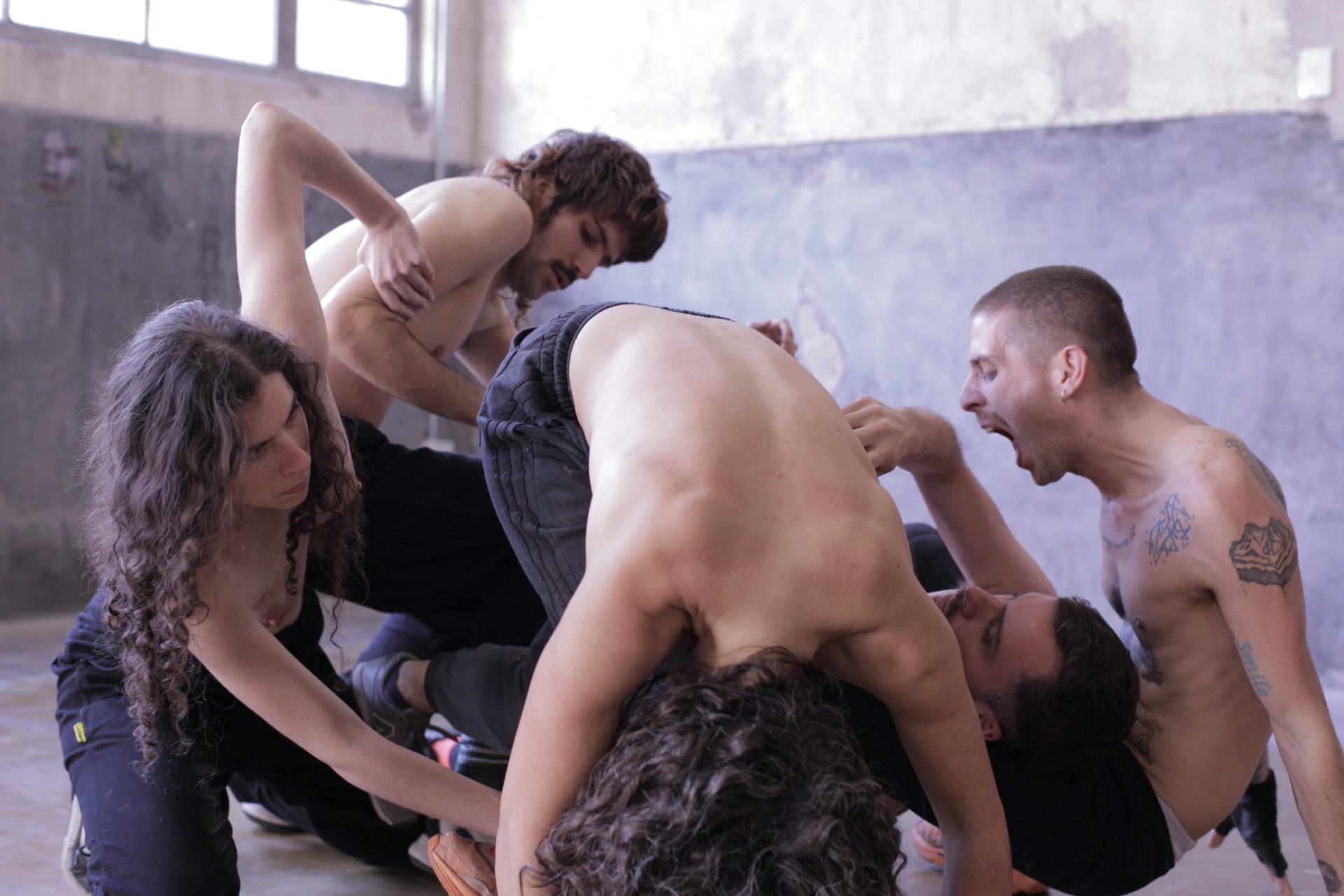
BP.21. “Academic” Section, a Liminal Space
Since 2015, I have directed the Academic Section of the International Performance Biennale (BP. 21).3 All the editions of this Biennale have been hosted by different cultural institutions in the City of Buenos Aires. The term "academic" is problematic because, generally, the term "academic" is linked to a degree of stability that performance problematizes precisely because it is an active and dynamic questioning of the processes of formal education. On the other hand, differentiating an "academic" section from an "artistic" section might lead to thinking that the production of knowledge would be on one side only, which is obviously not the case. Still, although in all the editions (2015/2017/2019/2021) the intention was to install a continuity between the "artistic" and the "academic" realms, in the current edition that distinction continues to exist. This shows the isolation in which the "educational" section is kept still, occupying a subsidiary position, “a peripheral place in relation to the curatorial core” (Moreno Martín, 1986: 4). We could say that it is a trans space, as Moreno Martín suggests, a liminal space that welcomes all which is difficult to classify, “where the transnational, the transgender, and the transdisciplinary find a place” (10).
In this liminal space, the program aims to develop proposals that are closer to the regional reality, to create an open, social and participatory space, a polyphonic and local space without a disciplinary regime that places students as faithful recipients who are required to memorize information devoid of any existential experience, or whose motivation is oriented towards acquiring the necessary skills to “take their place in a labor force stratified into classes, races, and sexes” (Giroux, 1985: 2-3). This program has considered:
«[...] the genealogies of critical pedagogies and their relationship with social movements, feminisms, and their critique of educational institutions and disciplinary society, and [also contemplated] the possibility of generating transversal alliances based on a mutual recognition among educators, artists, curators, and social movements.»
Cuerpos (re) situados [(Re) Situated Bodies] was the title given to this section — which is quite a broad term, by the way, since it has no clear boundaries. However, the name is but a starting point to trace diverse trajectories, given the complex dimensions of a proposal that has the possibility of being addressed from multiple perspectives. Moreover, it is not meant to produce a homogeneous closed discourse, for the interest is in the multifaceted and varied itineraries proposed by the artists and researchers participating in this edition.4 Thus, the purpose of this section is to make visible discourses, corporealities, and practices that do not conform to the norm and rather burst into it, intervening or transgressing it.
Cuerpos (re) situados are bodies that have changed places, bodies that crossed boundaries in their movement and, by crossing them, renewed conceptual lexicons from their new positions. A body that shifts its situation is a de-localized body, one that can go from one identity to another, from one gender to another, from one body to another — weaving forms of resistance to the devices of control and normalization from its new situation. Such bodies can take shape in numerous forms, that is why we chose to display their complex, multiple, and dynamic conditions. The interventions taking place in this section build spaces of resistance, critical views that destabilize set patterns of thought in different ways, according to a discursive and normative articulation.
The section comprises six interventions, one laboratory, and a seminar whose exhibition format does not respond to theoretical frameworks or institutionalized forms but proposes interventions arising from the bodies themselves, (re) situated as a living medium, creating a zone of interaction and generation of experiences in which to rethink the corporealities that are constantly traversed by the discourses of power. The curatorial work was assembled departing from three elements: the selection of discursive interventions, their display formats, and their possible subsequent textual productions.
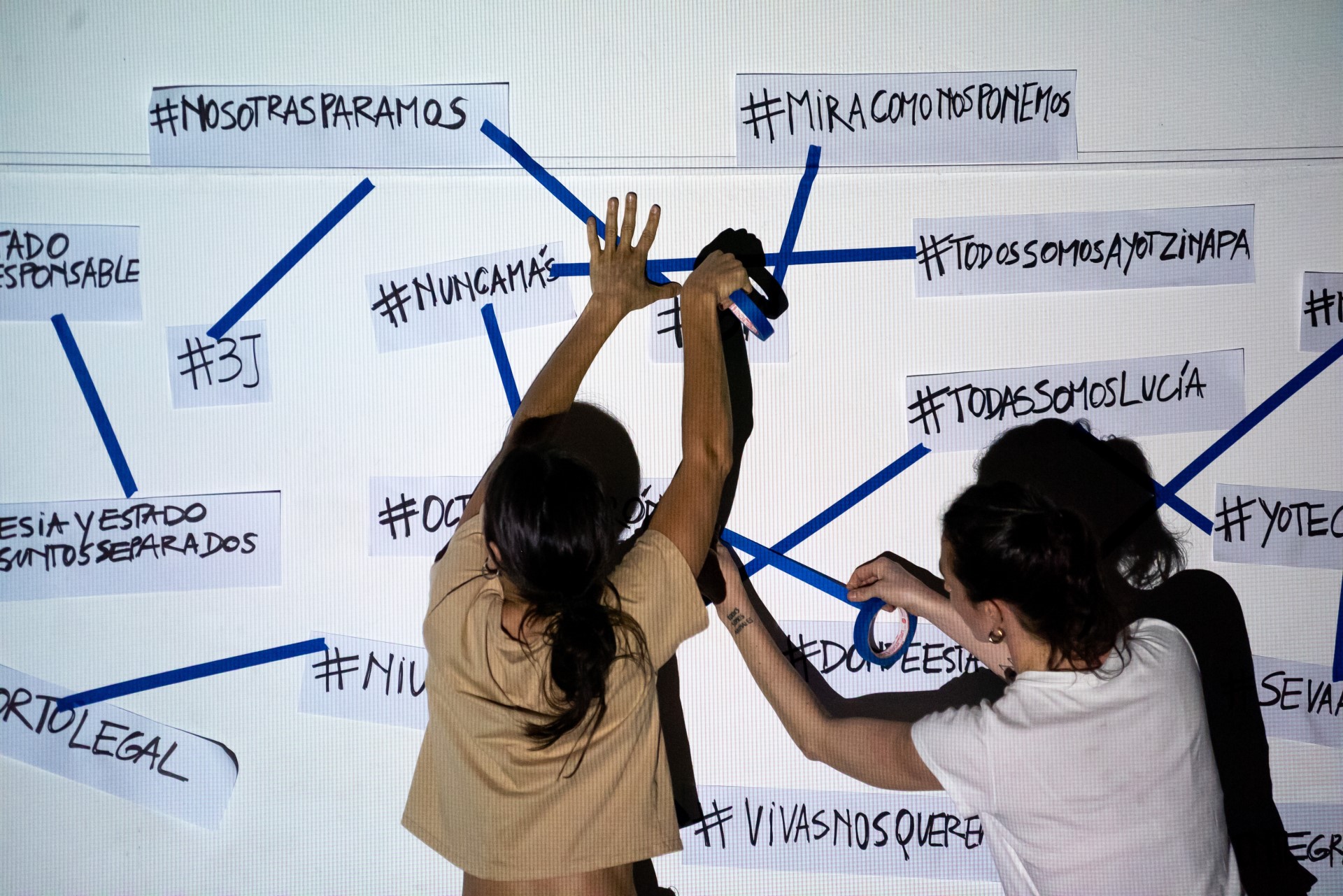


In #Mar: una conferencia nómada [#Mar: A Nomadic Conference], Marsha Gall, Margarita Molfino, and Alina Marinelli titled their intervention a nomadic conference, a surrogate performance. Molfino and Marinelli, in-person performers, take the place of Marsha Gall, who participates online. According to the authors, the idea of a traveling text implicit in the title "nomadic conference" and in the concept of "performative surrogation," indicates a displacement of bodies that change their situation and try to answer the following questions: How can we think together about space and the body when we are scattered? How can we mobilize collective corporeality from the fragmentary and interrupted?
In (Des)varíos sentimentales: una coreografía de ciencia f(r)icción [Sentimental Ramblings: A Science F(r)iction Choreography], Vir Cano and Bernardita Epelbaum allude to the “sentimental ramblings” of deconstructing the hetero-cis-normative love plots that patriarchal society has instated. This intervention questions the sentimental education while attempting to weave other love paradigms that destabilize the romantic love ideal and discourse, advancing toward wider affective frameworks. The second part of the title, “a science f(r)iction choreography,” alludes to science fiction as a speculative genre of possible worlds beyond the phallic adventure of the heteropatriarchal narrative, where everything is organized around a hero as the engine that mobilizes salvation. This choreographic conference points to the movement toward new ways of thinking about gender, sexuality, and identity in an ideal future.
In #Migrar #labellezadeungiro 'equivocado' [#Migrating #theBeautyofa‘Wrong’Turn], Florencia Mazzadi and Mariela Bond work with archival images from the Migrant Film Festival, which recount how the system determines the uneven distribution of opportunities and ways of living and dying. The archival images address the ways in which racial differentiation shapes our bonds and how ‘re-situated’ lives differ “from the lives that will be safeguarded, reproduced, and futurized and those that will simply be forgotten and discarded or even sacrificed to guarantee the stability of the socio-economic system” (Estévez Ballestero, 2018: 2).
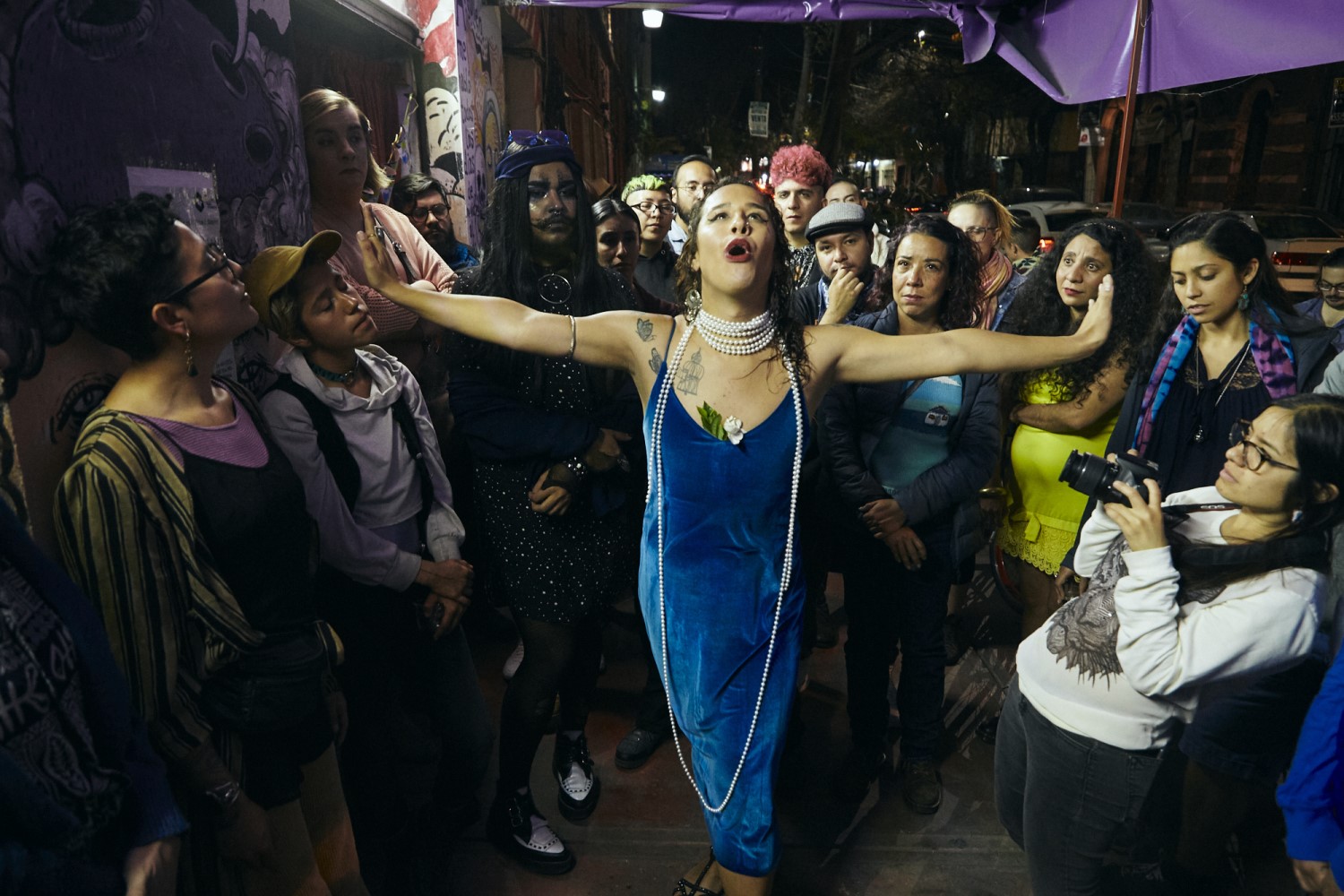
In Ternura llévame contigo. O de cómo los afectos transforman, transgreden [Tenderness Take Me with You. Or How Affections Transform, Transgress], Guille Mongan, Po Shitsa (Sirena Popular), and Lía García (La Novia Sirena) attempt a three-voiced performative conversation about the Pedagogy of Tenderness, to which Lía adds the adjective ‘radical.’ According to the authors, the goal is to recover the affective sense of our bodies and subjectivities so that, by moving away from rational and theoretical processes, trans bodies can heal and realize all the possible worlds and stories inhabiting their dreams. The Pedagogy of Tenderness is part of a long-standing movement. Alejandro Cussiánovich, its creator, traces this idea back to the nineteenth century when he refers to a pedagogy based on amorevolezza (close and affective educational relationship), which is also linked to what Paulo Freire defines as Pedagogy of Hope: an educational process whose axiological framework is based on affection as a mediator of all relationships. Lía, Guillermina, and Po Shitsa expose affection as a trigger for trans*inclusive feminism, “in a society where violence towards sexual and gender dissidence has worsened, and where each trans life is an undisciplined miracle" (Sánchez Villarreal, 2021: n/p).
In Cuestionario prost: intimidades de una puta [Prost Questionnaire: Private Affaires of a Whore], Dolores Curia and Georgina Orellano expose how feminism has historically excluded certain groups, not only lesbian, black, Muslim, or trans fellows sisters, but there is also a history of exclusion within feminisms towards prostitutes. During the weeks prior to the event, the social networks will be the medium through which audiences will bring up their concerns and comments. This encounter aims to display the life and thoughts of one of the most resounding activists of a collective that fights against clandestinity and moralism.
In Vidalita5 o la melodía trans en el cine argentino [Vidalita or the Trans Melody in Argentinian Cinema], Ricardo Manetti and María Valdez delve into the construction of transvestite characters in the Argentinian film discourse. This intervention addresses the criollista imagery based on the national cult of courage as a symbol of Argentinian identity; on the countryside as an idyllic locus in opposition to the depravation of the city; on the heroic values that characterize the gaucho, and the way in which cinema operates as a creator and recreator of cultural imaginaries. With a dose of humor, this lecture will expose the ways in which sexually-dissident identities played a role within these coordinates, problematizing the performative way in which gender identity operates both in the fixation of stereotypes and social roles, and in the perception of sexual dissidence.
In Para inducir al espíritu provocador de las imágenes [For Inducing the Provoking Spirit of Images], Guillermina Mongan, Jorgelina Mongan and Gonzalo Lagos will carry out an experience exploring points of contact between images that have crossed our sight and their relationship with the concept of “provocation.” According to the authors, the experience is based on the collective construction of a visual imaginary around what we perceive as provoking. Through linking conceptual, curatorial, and corporal devices the authors rehearse the different possibilities on how to summon, provoke, or induce (some kind of new épater le bourgeois?) the belligerent nature of artistic practices.
In Entornos virtuales: una construcción de ficciones posibles [Virtual Environments: A Construction of Possible Fictions], Iván Haidar addresses the problem between the in-person body and its image-replica installed in a sort of “digital purgatory”. A place where these (re) situated bodies announce the inauguration of a new aesthetic sensibility and the beginning of a dynamic process of transformations, in which the body can no longer be assigned a stable and fixed locus.
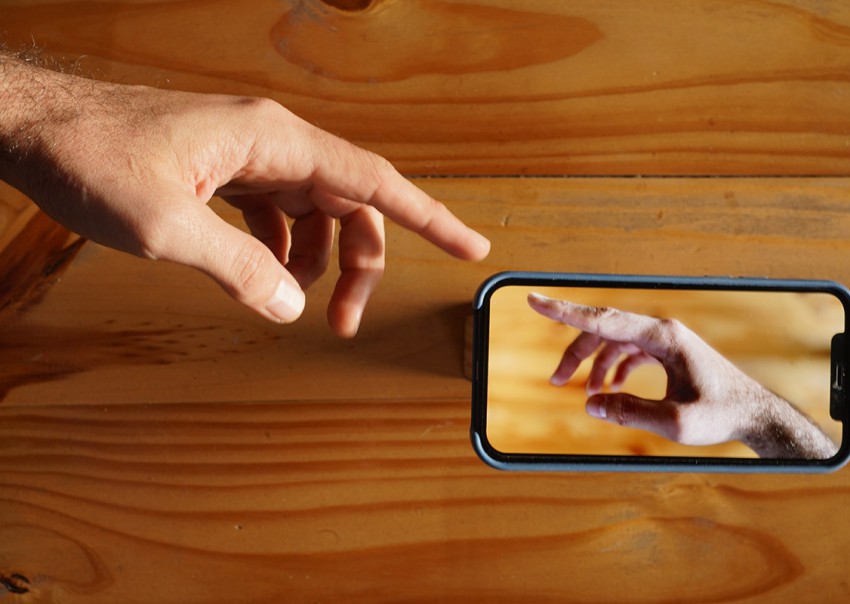
Final Words
This hybrid common ground between the fields of art and education is led by artists with a questioning and critical capacity, with different organizational forms based on placing processes and experimentation at the center. They do not reproduce the traditional formats and models of lectures, workshops, and conferences; on the contrary, they pursue a critical approach understood as an exercise in reflection, as building experiences capable of counteracting the power relations that exist within the institutionalization of formal education. The proposals presented are inscribed within the historical conditions, social contexts, and cultural relationships of the environment where they unfold.
Although this is an educational activity produced outside the institutional system, it does not ignore “the phagocytic nature of the system,” which can “stubbornly impose its own logic, turning the most combative gesture into a mere grimace." Thus, it remains a valid question "whether institutional criticism is effective enough to overturn the power strategies from within power" (Soria Ibarra, 2018: 22-23).
